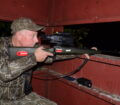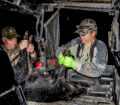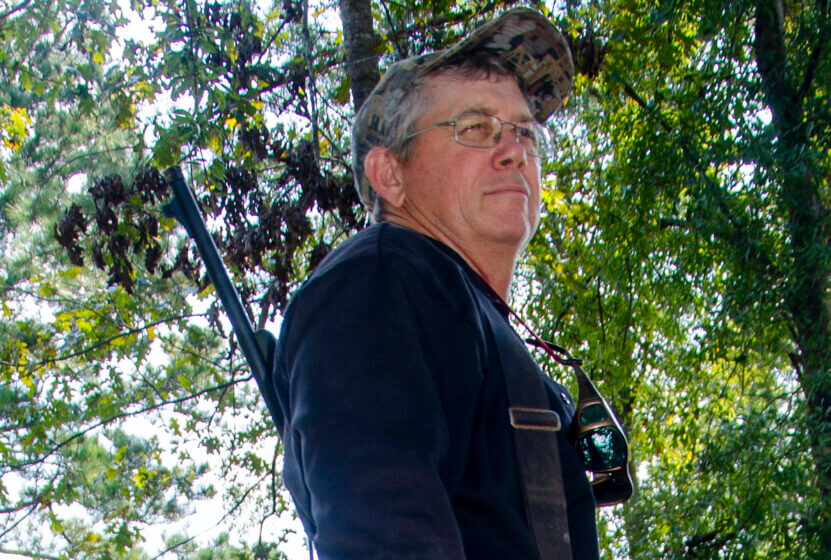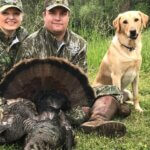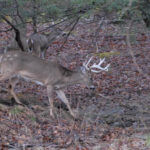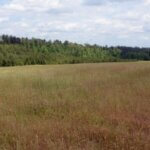Editor’s Note: Biologists name feral hogs and their high-reproductive rate as the worst critters in the woods for destroying ground-nesting birds’ nests, like grouse, bobwhite quail and turkeys, eating their eggs, outcompeting deer for natural food, besides destroying crops, rooting-up green fields, eating supplemental feed intended for deer and turkeys, rooting-up roads, killing newborn fawns, threatening wetlands’ habitat and destroying ecosystems. Mark McKenna owns and operates the McKenna Ranch, which consists of 5000 acres of hunting land, near Pachuta, Mississippi , (https://www.facebook.com/mckennaoutfitters/), 601-692-3224 and mckranch.mark@gmail.com. Like many sections of Mississippi and almost all of the U.S., the McKenna Ranch has a wild hog problem.
 Once McKenna got with his worker who had been hunting wild pigs on the Mississippi Coast, McKenna used Sightmark digital riflescopes (https://sightmark.com/) and Pulsar Thermal Imaging Binoculars (https://www.pulsar-nv.com/) to scan for hogs to save the battery life on the riflescopes when he used the riflescope on a bolt action Savage .308 (https://www.savagearms.com/impulse).
Once McKenna got with his worker who had been hunting wild pigs on the Mississippi Coast, McKenna used Sightmark digital riflescopes (https://sightmark.com/) and Pulsar Thermal Imaging Binoculars (https://www.pulsar-nv.com/) to scan for hogs to save the battery life on the riflescopes when he used the riflescope on a bolt action Savage .308 (https://www.savagearms.com/impulse).
Here’s a rundown on McKenna’s gear for night-hunting hogs. “I have one silencer on one of my rifles and use subsonic 9mm ammunition. A .308 is a common round and has a lot of knockdown power. In fact, this .308 Savage is called a hog hunter’s special. It’s threaded on the end of the barrel to accept the newer silencers that often are used by hog hunters. By using the pistol silencer along with a 9mm ammo, a hunter often can take three or four wild hogs before the hogs determine what’s happening. We also can bait hogs in Mississippi to get them to come into a feeder where we can harvest them at night. Except during deer season when you can’t hunt wild pigs at night, we can hunt them like this all year long, and we can take as many as we want to clean because there’s no limit.
“The Commissioner of Agriculture and Commerce for the State of Mississippi, Andy Gipson, has been waging war on hogs. The state even will loan you one of those hog traps that has a camera on it. Be sure to see how many hogs are inside it before you drop the door to keep the hogs in that pen. These traps also send a signal to your phone to let you know when the hogs are inside of it. Bait for the hogs, so they’ll come into the trap every day and night. This way, you can identify each hog and not drop the door until you have the entire sounder (a group of wild pigs that travel together) in the trap. Wildlife biologists have learned that the best way to control hogs is to trap and kill the entire sounder (or sounders) that are causing problems. We not only have night hog hunts, but during deer season, we allow our hunters to take one buck, one doe and one hog on a two-day weekend hunt.”

McKenna mentions that there are several areas where they try to bait hogs for night hunting and then decide where to place hunters based on the wind. “Hogs have poor eyesight, so if they see you, there’s a chance that they won’t know what you are and won’t run away. But if they smell you, they’re gone in an instant. At night, our hunters hunt out of box stands. Also, we use trail cameras to know what direction the hogs will come in to the feeders before our hunters get in the stands late in the afternoons.
“Hogs learn really quickly from which direction danger usually comes. One of my hunters put it best when he said ‘Deer operate off instinct, and hogs operate off their intelligence.’ Our hunters are allowed to take two hogs per night per person, unless we have one area where we feel we need to take more than two per night. When riding around in our side-by-side looking for hogs with our thermal-imaging binoculars, we have taken as many as 12 in a night.”
You would think that as much hunting pressure as Mark McKenna and his guests put on the hogs, that they would be reducing the number of hogs on the property, however McKenna explains, “The State of Mississippi’s website says, ‘You need to take 70% of your population of hogs off the property each year to maintain the same number of hogs on your property year after year.’ By taking 70% of the hogs you’re not reducing the population of hogs – you’re just maintaining the same population year after year. So, to reduce the number of hogs on your property you have to take more than 70% every year.” When asked how many hogs McKenna thought were holding on the 5,000 acres that he hunts, he answered, “Hundreds. And even when we start harvesting them by hunting, they don’t leave the property like they once did. They stay right here and continue to produce more hogs.”
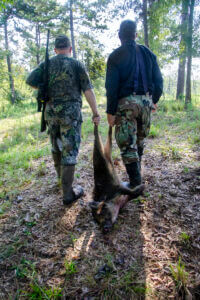
McKenna doesn’t hunt out of the same stands every weekend and only conducts night hog hunts on the weekends. Guests hunting at the McKenna Ranch should plan to arrive 3 hours before sunset, meet in the dining hall to learn how to operate the digital night-vision riflescopes, and then go to the shooting range to sight-in the rifles. Then hunters are ready to get in their box stands for a night of hunting. One thing you’ll notice right away is that these rifles with the night-vision scope weigh about 10-pounds each. However, hunters can use the edge of the window cut into the box stand to rest their rifles, aim and take hogs. The shooting houses are 4-feet wide and 6-feet long and can accommodate two people. “Many times we’ll have a father and son, or a father and daughter hunting together,” McKenna explains. “We get quite a few husbands and wives who want to hunt together, as well.”
Hogs, according to McKenna, will eat every acorn in the woods they can find, so they’re competing with deer, turkeys, squirrels and every other critter that depends on acorns for food. They also root-up green fields, making them more difficult to plow and plant. McKenna mentions, “The last time I planted corn 12-years ago, I had a great stand of corn. But, the week after I checked my corn, that corn field looked like a crazy person had taken a four wheeler and tried to knock-down every stalk of corn and tear-up all the ground where the corn was planted. That was the last time I tried to plant corn.” And, McKenna’s not the only rancher or farmer who’s having hog problems. All of his neighbors share this same problem.
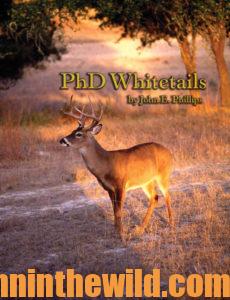 Some wildlife researchers have learned that deer tend to stay away from areas with wild pigs. To learn more about hunting for deer, check out John E. Phillips’ book, “PhD Whitetails: How to Hunt and Take the Smartest Deer on Any Property,” available in Kindle and print at http://amzn.to/WIEUoo and Audible at https://www.audible.com/. You may have to copy and paste this link into your browser. (When you click on this book, notice on the left where Amazon says you can read 10% of the book for free and hear 10% for free). On the right side of the page and below the offer for a free Audible trial, you can click on Buy the Audible book. To see more of John’s deer hunting books, visit www.amazon.com/author/johnephillips.
Some wildlife researchers have learned that deer tend to stay away from areas with wild pigs. To learn more about hunting for deer, check out John E. Phillips’ book, “PhD Whitetails: How to Hunt and Take the Smartest Deer on Any Property,” available in Kindle and print at http://amzn.to/WIEUoo and Audible at https://www.audible.com/. You may have to copy and paste this link into your browser. (When you click on this book, notice on the left where Amazon says you can read 10% of the book for free and hear 10% for free). On the right side of the page and below the offer for a free Audible trial, you can click on Buy the Audible book. To see more of John’s deer hunting books, visit www.amazon.com/author/johnephillips.
Tomorrow: Michael Jones’ Nighttime Wild Hog Hunt

